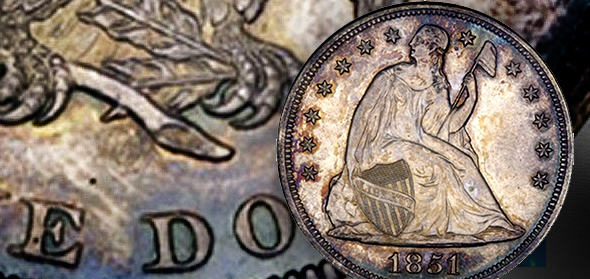
Photo credit: Ira & Larry Goldberg | Composite: CoinWeek
By Jeff Sherid for CoinWeek….
Struck between 1840 -1873, they are one of the greatest coin types for collectors and investors alike. Seated Liberty dollars were struck in Philadelphia, San Francisco, New Orleans and Carson City.
In my opinion, they are one of the most interesting types of coins ever minted and are endowed with one of the most beautiful designs ever produced by the United States Mint.
As with most coin types, Proofs were struck in much lower numbers than the typical business strikes. Nearly all Proof coins were struck in Philadelphia- although, on occasion an exception was made to this policy, and a proof strike was executed at one of the branch mints. These “Branch Mint Proofs” are quite rare and quite desirable, when they occur.
Unlike gold Proofs of the period, Seated Liberty dollar Proofs are more readily available to collectors and investors as Silver Dollar proofs were struck in much higher numbers. That doesn’t make them plentiful, however, nor is this rule hard and fast throughout the series, as some issues in the series are quite rare.
Take the 1840, for instance. It’s purported that that issue saw only 50 examples struck. 50 may not seem like a lot, but that number towers over the 12-15 Proofs that were reported struck from 1841-1846. Production “inched up” to 15-20 pieces from 1847 to 1850.
In 1851, the number jumped back to 50 coins struck. Production dipped again in 1852 and 1853 and it wasn’t until 1859 that significant numbers of the coin were struck for collectors. Thereafter, a sufficient number of coins were struck that today’s collectors should have ample opportunity to find examples for their collections.
As is the case with most federal issues, the scarcest dates bring in big dollars at auction. This is true for business strikes and proofs. Take for instance the 1870-S business strike- the rarest regular strike issue in the series with a reported 12 coins struck. In May of 2015 an XF40 example crossed the auction block and brought a whopping $505,250.
As rare as that coin is, and some of the Proof issues I’ve already mentioned in this article, none of these coins have the distinction of being the rarest Seated Liberty dollar.
That distinction belongs to a highly unusual coin struck bearing the date 1851.
That coin is a Branch Mint Proof- a coin that was on nobody’s radar until it was discovered a few years ago. Whether it was struck in New Orleans or in Philadelphia using a reverse “O” mint die, nobody really knows… However what we do have is a coin that bears the markings for a New Orleans coin.
Since its discovery, the 1851-O Proof has been graded by PCGS and certified by CAC, making it the ONLY Branch Mint Proof in the series ever recorded.
Little is known about the coin. The issue does not appear in the GUIDEBOOK. Nor does it appear in Walter Breen’s “Encyclopedia”. Those looking for Mint records of the coin’s striking will also be disappointed as it does not show up in Mint Reports for the period, either. Nevertheless, this is an authentic coin that was struck at the U.S. Mint, albeit possibly under suspicious circumstances.
Breen believed that this coin was struck surreptitiously at the Philadelphia Mint sometime in the 1860’s to 1870’s by employees utilizing an 1851 Obverse and an “O”-mintmarked Reverse. He believed that whoever struck this piece attempted to remove the mintmark upon discovering that they had inadvertently created a previously unknown rarity.
Through my research, I found information that in 2002, Ron Guth examined the coin in the offices of Ira & Larry Goldberg Coins & Collectibles, Inc. and he viewed the coin with the following possibilities in mind:
Possibility #1: that this was indeed a muling of an 1851 Obverse with an “O”-mintmarked Reverse. Finding: the mintmark is clearly visible but completely flat. While there are some very fine, almost microscopic scratches in the area of the mintmark, I believe that this was an attempt to efface the already flattened mintmark, not to remove a raised mintmark.
Possibility #2: that a Silver Dollar previously struck at the New Orleans Mint was mistakenly overstruck in the process of creating an 1851 Restrike Silver Dollar. Since no Silver Dollars were struck at the New Orleans Mint in 1851, the only possibilities for the host coin were the 1846-O, 1850-O, 1859-O, and 1860-O dates.
The fact still remains that here is a Seated Dollar with an “O” mintmark on the reverse in Proof making it the most UNIQUE coin of the entire series.
In 2008, this coin sold in auction for over $374,000, a great price for the rarest piece of the series. There was heavy bidding on the coin in 2008 with a reported five floor bidders vying for this UNIQUE dollar. Everyone has an opinion about this coin and how it was struck or why it was struck but in the end, there is an 1851-O Proof dollar that exists….. and the coin is listed in the “100 Greatest U.S. Coins” book, third edition at No. 70.




